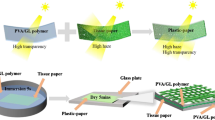Abstract
White polymer light emitting diode (PLED) has attracted the interest of researchers by the advantage of having low cost, flexible light sources. One of the major advantages of PLED is that it can be able to fabricate in flexible plastic substrate instead of glass substrate. Generally PLED’s requires a substrate of high refractive index to enhance the amount of trapped light in the device, but the refractive index of flexible plastic substrate is low (n < 1.6). In this paper, we present a white PLED on a flexible plastic substrate with a new enhancement method. In which the semi-transparent gold layer is sandwiched between the layers of tantalum oxide and molybdenum oxide which does not require a high refractive index substrate. Using this design, the extraction efficiency of the device is increased from 1.5 to 2.1 cw compared to that of the device using glass substrate.
Similar content being viewed by others
References
Adachi C., Baldo M.A., Thompson M.E., Forrest S.R.: Nearly 100% internal phosphorescence efficiency in an organic light-emitting device. J. Appl. Phys. 90, 5048–5051 (2001)
Baldo M.A. et al.: Highly efficient phosphorescent emission from organic electroluminescent devices. Nature 395, 151–154 (1998)
Fei T., Wang C., Xue S., Gu X., Li F., Ma Y.: Highly efficient pure yellow electrophosphorescent device by utilizing an electron blocking material. Mater. Chem. 18, 4802 (2008)
Forrest S.R.: The path to ubiquitous and low-cost organic electronic appliances on plastic. Nature 428, 911–918 (2004)
Helander M.G. et al.: Oxidized gold thin films: an effective material for high-performance flexible organic optoelectronics. Adv. Mater. 22, 2037–2040 (2010)
Kawamura Y. et al.: 100% phosphorescence quantum efficiency of Ir(III) complexes in organic semiconductor films. Appl. Phys. Lett. 86, 071104 (2005)
Liu S., He F., Wang H., Xu H., Wang C., Li F., Ma Y.: Cruciform “DPVBi: synthesis, morphology, optical and electroluminescent properties”. J. Mater. Chem. 18, 4802 (2008)
Mikami A., Koyanagi T.: 60.4L: Late news paper: high efficiency 200-lm/W green light emitting organic devices prepared on high-index of refraction substrate. SID Symp. Dig. Tech. Pap. 40, 907–910 (2009)
Mladenovski S., Neyts K., Pavicic D., Werner A., Rothe C.: Exceptionally efficient organic light emitting devices using high refractive index substrates. Opt. Express 17, 7562–7570 (2009)
Moon J.-M., Bae J.-H., Jeong J.-A., Jeong S.-W., Park N.-J., Kim H.-K., Kang J.-W., Kim J.-J., Yi M.-S.: Enhancement of hole injection using ozone treated Ag nanodots dispersed on indium tin oxide anode for organic light emitting diodes. Appl. Phys. Lett. 90, 163516 (2007)
Reineke S. et al.: White organic light-emitting diodes with fluorescent tube efficiency. Nature 459, 234–238 (2009)
Reineke S., Rosenow T.C., Lüssem B., Leo K.: Improved high-brightness efficiency of phosphorescent organic LEDs comprising emitter molecules with small permanent dipole moments. Adv. Mater. 22, 3189–3193 (2010)
Thomschke M., Nitsche R., Furno M., Leo K.: Optimized efficiency and angular emission characteristics of white top-emitting organic electroluminescent diodes. Appl. Phys. Lett. 94, 083303 (2009)
Watanabe S., Ide N., Kido J.: High-efficiency green phosphorescent organic light-emitting devices with chemically doped layers. Jpn. J. Appl. Phys. 46, 1186–1188 (2007)
Wei B., Yamamoto S., Ichikawa M., Li C., Fukuda T., Taniguchi Y.: High-efficiency transparent organic light-emitting diode with one thin layer of nickel oxide on a transparent anode for see-through-display application. Semicond. Sci. Technol. 22, 788–792 (2007)
Zhang H.M., Choy W.C.H.: Indium tin oxide modified by Au and vanadium pentoxide as an efficient anode for organic light-emitting devices. IEEE Trans. Electron Devices 55(9), 2517 (2008)
Author information
Authors and Affiliations
Corresponding author
Rights and permissions
About this article
Cite this article
Shanmuga Sundar, D., Sivanantharaja, A. High efficient plastic substrate polymer white light emitting diode. Opt Quant Electron 45, 79–85 (2013). https://doi.org/10.1007/s11082-012-9604-x
Received:
Accepted:
Published:
Issue Date:
DOI: https://doi.org/10.1007/s11082-012-9604-x




